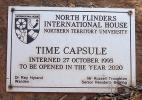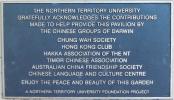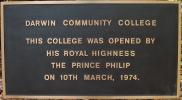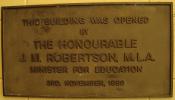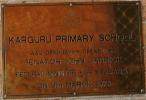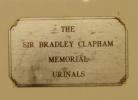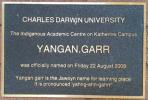This review was first published in Northern Territory Historical Studies, No 27, 2016, pages 102-104. All photos in this review, except the image of the Sydney ceramic plaque, were taken by Steve Farram and displayed in an online exhibition marking Charles Darwin University’s silver anniversary.
The study of commemorative plaques, among historians at least, is an arcane, some might say neglected, field. Steve Farram’s A History Written in Metal addresses this neglect, at least for the Casuarina Campus of Charles Darwin University (CDU). The campus is a perfect microcosm for investigating and analyzing a discrete collection of plaques.
Chapter One sets the scene for subsequent chapters that identify, describe and analyse the plaques decade-by-decade. Each plaque is illustrated, with its location, a brief history of the building or subject commemorated by the plaque, and some biographical details of the person or people named on the plaque. Chapter Eight provides conclusions, with an appendix of plaques at other CDU campuses, a detailed bibliography and a good index.
Farram’s interest was provoked by serendipity: “I became interested in the plaques at Casuarina campus … through the chance discovery of two plaques in rather improbable places”. One was inside the third level of a building; the other had been relocated to the centre of a roundabout. These discoveries, in the context of CDU’s approaching 40th anniversary, gave him an opportunity to research a history of the university beyond the usual paper archives.
The introduction will be of most use to researchers beyond Darwin. Farram describes the university’s commemorative plaques as a “type of institutional autobiography”. However, they cannot be taken at face value: attention is needed to the facility being commemorated, those opening the facility, and the entity providing the funding. The plaques almost always have some political significance, and collectively tell a story of the educational aspirations of a regional community.
The discussion of ‘The significance of plaques’ is of universal value. Farram observes that “Not much has been written about the use of commemorative plaques as an aid to understanding the history of a site or institution”, an observation with which I completely agree. To counter this void, he compares other approaches to historical research using material evidence, such as buildings and objects. Plaques, he notes, do contain text, but it is a special kind of text that we have to learn how to read. Monuments have attracted some scholarly attention, but academic historians, he argues, have retained a “traditional antipathy to public history” (and in those few words is the basis for a whole new book!).
Plaques are subject to all the usual caveats: they are partial and biased, they leave unsaid as much as their inscriptions seem to say, they can be misleading, dates can be inaccurate. Nevertheless, they can also reflect civic culture, be a source of community pride, and record changing social and political paradigms. Farram reflects on the distinctions between history and heritage, quoting Susan Marsden “heritage is not what happened in the past but what has survived from the past”. Plaques are both material survivors of the past, and a written record of it. Those that are not destroyed or otherwise displaced will become heritage items in their own right. He finishes by stating that textual evidence in the paper archive is available to those determined, trained and experienced enough to access it, whereas plaques are available for all to see. This is a fundamental observation, and explicitly informed the establishment of the London blue plaques program in 1867 and the Sydney ceramic plaques program in 1919.
Farram identified 53 plaques, of which five and possibly more are known to be missing (about ten percent). My own research on plaque programs in Sydney, London and Manchester suggests that a quarter to a third will be missing after the first forty years. Darwinians may be better guardians of their patrimony, but I suspect further research would reveal more missing plaques. He touches upon the often-poor quality of the materials used to make the plaques, and the scarcity of authenticating emblems such as coats of arms. This leads to the counter-intuitive realization that plaques, supposedly intended to be enduring, are often treated as little more than publicity opportunities. This is especially evident in the now-common practice of a plaque being unveiled while sitting on an easel. Permanent attachment to the place, it seems, is increasingly becoming something of an optional afterthought.
There are some matters that might have been touched upon a little more, such as why particular plaque materials were chosen. However, the strengths of the book far outweigh any such weaknesses, especially as it is in many ways a pioneering work. Farram alerts historians to the presence of commemorative plaques in the landscape, and their role as historical records. His self-effacing comment that “…nothing profound is likely to be learnt …” from his book is too modest.
A History Written in Metal is a must for any historian of CDU, regionalism, post-school education, heritage and especially the tiny (but hopefully expanding) field of ‘plaque studies’.
Steven Farram, A History Written in Metal: Commemorative Plaques at Charles Darwin University’s Casuarina Campus, 1972-2013, Historical Society of the Northern Territory, Darwin, 2014, ISBN 978-1-921576-99-7, xxi + 214 pp, paperback, $25.00

